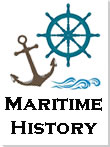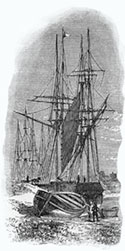Maritime History of Newport
By Peter Brown
© Peter Brown 2024
Shipping management
As the volume of shipping increased in the 19th century, the management of shipping was operated mainly by two types of organisation: shipbrokers, who were specialist intermediaries/negotiators between shipowners and charterers who used ships to transport cargo, or between buyers and sellers of vessels; and shipping agents, who were licensed agents in a port who transacted a ship's business, such as insurance or documentation, for the owner. This chapter examines the work of these bodies and some of the issues managing the fleets and the enormous loss of ships that was an inherent problem of the times.
The registration of shipping became compulsory in 1786, so we have some early records of the ships belonging to Newport, including the brig Good Intent, the sloops Tredegar, Friendship, Three Friends, Providence, Frederick and Thirza, and Moderator. The sloops Carlion, Betsey and Five Brothers of Caerleon all belonged to Caerleon.[1]
The earliest detailed records in Newport are for the year ended 30th September 1823 and include some ships built before that date.[2]
| Ship | Tonnage |
Type of trade |
Master |
Crew |
Lady Rodney |
58 |
Steam Packet - Coast |
Wm. Young |
8 |
William |
120 |
Coast and Irish |
Wm. Williams |
7 |
Tredegar |
62 |
Coast |
Wm. George |
4 |
Trial |
31 |
Coast |
Jas. Stone |
3 |
The Tredegar was a 64-ton sloop with a standing bowsprit, owned by Thomas Powell and William George and built at Newport in 1787. Another vessel of the same name – owned by William Jones and Thomas Webb – made her first voyage in 1804 but was lost off Milford Haven in 1829.[3] The Carlion, a smack with a running bowsprit of 63 tons, was built in 1803 and owned by John and William Jenkins. Other ships were the John and Mary (73 tons), built in 1814; the Sarah (88 tons), built in 1818; and the Sisters (74 tons), built in 1822.
Perhaps we should not be surprised today at the number of lost ships, but it still reads as a depressing catalogue of lost ships and lives.
An enquiry held in March 1839 (the year of the Chartist rising in November) records the details of the schooner Ann (150 tons) and her remarkable return from Canada against the odds.[4] The ship left Prince Edward Island with a cargo of deal boards on 15 November 1838. Constant gales battered the ship relentlessly, and on 1 December, it lost its foremast and suffered other damage, with one man lost overboard and the crew exhausted. Five days later, they managed to rig a temporary foremast and made progress homewards. Despite taking on water, they limped to Lundy Island by 15 December and reached Newport the following day.
Another enquiry, held the following month, records the details of a similar return voyage by the Economist (323 tons) of Newport carrying a cargo of timber, deals and lath wood from Quebec.[5] A week after leaving on 1 November, hurricane conditions caused massive damage to the masts and deck, carrying away the rainwater casks. Ballast choked the pumps, resulting in 5’ of water in the hold. There were further storms and damage, but the crew managed to pump sufficiently to save the vessel, which reached Lundy and then Newport on 3 December with 5’ of water still in the hold.
Scott recorded the following details of Coal and Iron Wharves in 1847, with details of their agents, shippers and conveyances:[6]
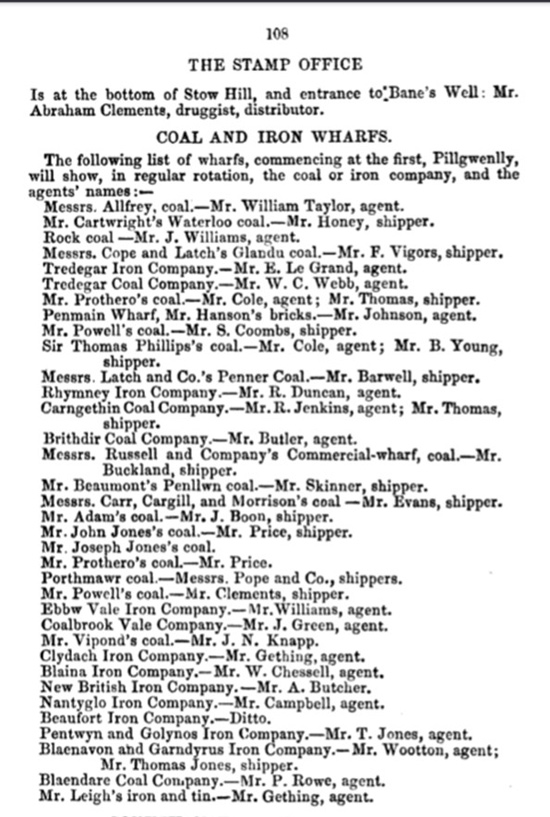
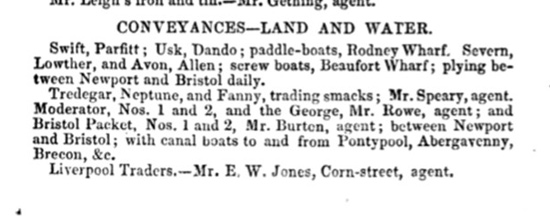

The record for ships owned and registered at Newport was 120 in 1867, totalling 23,686 tons.[7] Many of these ships were not constructed at Newport, and one of the largest and finest vessels ever belonging to Newport was the three-masted Norwood (1233 tons) built at Quebec in 1853 and purchased by Mr Wm Childs Webb of Newport. She foundered 14 years later, heading to Liverpool.[8]
Interestingly, between 1850 and 1875, several vessels were built for, or purchased by, Newport owners from Prince Edward Island, Nova Scotia.[9] Most of these ships were brigs, ranging from 200 to 250 tons, but a few were barque rigged, with a higher tonnage from 300 to 500 burden. The records suggest that most of these vessels came to untimely ends, with few lasting more than five years, as the following table shows: [10]
| Name | Tons |
Original owner |
Notes |
Frank |
213 |
J. N. Knapp |
Wrecked near Gibraltar (1868) |
Surprise |
228 |
Robt. Gething |
|
Onward |
257 |
William Williams |
Foundered at anchorage in the river Plate (1866) |
Courier |
209 |
David Price |
Abandoned at sea (1876) |
Saladin |
199 |
Wm. Childs Webb |
|
Matchless |
298 |
William Williams |
Lost in the Atlantic (1866) |
Mattie |
260 |
Thos. Beynon |
Lost off the Bahamas (1866) |
Progress |
299 |
Chas. W. Ingram |
Lost near Haiti (1867) |
Bellona |
247 |
James Harman |
|
Florence Pope |
207 |
Thomas Heal |
Abandoned at sea (1870) |
Superb |
431 |
J. N. Knapp |
Lost at Santa Anna (1866) |
Maggie |
241 |
Wm. C. Webb |
|
Prairie Flower |
205 |
J. Maddocks, E. Le Grand and others |
|
Lizzie |
295 |
Wm. Pugsley |
|
Frances Graham |
195 |
James Graham |
Lost in the Gulf of Mexico (1865) |
Princess Alice |
356 |
R. Gething, Jr. |
|
Amity |
271 |
Wm. Williams |
Lost off Port Charlotte, Florida (1875) |
Prairie Gem |
269 |
Jas. Tadd |
|
Sunbeam |
212 |
W. S. Lang |
Lost in the Atlantic, west of Spain (1868) |
Juniper |
230 |
Wm. Pugsley |
|
The following steamships belonged to Newport in 1890:
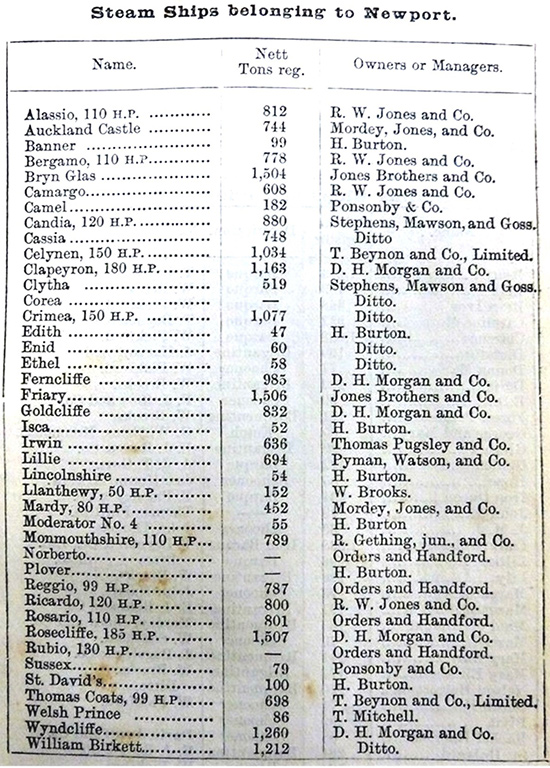
Shipping losses
The most tragic period for Newport shipping was from 1860 to 1870, when 84 vessels (17,665 tons) belonging to the port were wrecked.[11] In 1861, as an example, the Bellona foundered in the Mediterranean, the Raglan was abandoned in the Atlantic, and the Mary Ann Dufus (318 tons) sank after a collision in the Bristol Channel. October of that year saw three disasters in 7 days, with the General Havelock (225 tons) lost 70 miles southwest of the Scilly Islands, the Alert (378 tons) lost off the Cornish coast, and the Young Gipsy lost off Rhyl. The Favourite soon foundered off Brittany and the Doctor Bunting (433 tons) in the St. Lawrence in Canada on the timber trade.
In 1863, the sloop Tredegar of Newport capsized and sank off Clevedon, bound for Bristol. The Master and three of her crew drowned, but one man survived on a plank and was rescued by a fisherman. He was found insensible but brought ashore and survived.[12]
Other losses in 1863 included Eleanor, Lavinia, Susannah, Victory and Usk. The Usk provides an interesting case study of superstition at sea.[13] She was a 3-masted sailing vessel of 338 tons, barque rigged, carvel built, and with a full female figure at the bow. Built at Newport in 1859, she was owned by Mr Thomas Gratrex, with Mr Thomas Beynon and Mr Charles Nicholson becoming part owners later. In March 1860, she left Newport for Valparaiso (Chile) with a cargo of coal. Nearing Cape Horn, she encountered heavy weather and sludge ice, and it was decided to turn back and make for the Falklands. There, her Captain, Henry Mathias, informed the Chief Officer that he had seen a vision from God who ordered him to return immediately to Newport, and if he disobeyed, the ship, her cargo and crew would all be destroyed by fire. The Captain threatened to charge the ship’s company with mutiny if they did not follow orders, and the Chief and Second Officer consulted the crew. Such was the superstition inherent in mariners that the decision was taken to return, with only three members wanting to carry on. The Usk raced home in record time, to everyone’s surprise back in Newport. Captain Mathias recounted the story of his vision but was relieved of his command. The cargo was safely discharged at the Old Town Dock to cool, then re-shipped in the Usk to Valparaiso. After three further years of regular trading, the Usk’s cargo of coal burst into flames off the South American coast and the ship was lost. The same fate befell the Newport barques Herbert Graham (318 tons) and Minnie Graham (273 tons) off the coast of Chile in 1873.[14]
Another Newport ship, the Caerau, was built in Sunderland in 1865. She was restored by Mordey and Carney and started regular trade with Spain, bringing iron ore from Bilbao.[15] After setting sail in March 1888 from Bilbao during a storm, she disappeared without a trace. The Gleaner was more fortunate when leaving Spain for Newport with a cargo of iron ore later that year. Following problems caused by a gale, the ship sank slowly, although the crew were all picked up.
In January 1887, the Lloyds agent at Lisbon telegraphed that information had been received from Peniche (Portugal) that the British Steamship Brentford, travelling from Newport to Malta, had been wrecked, with only one survivor. The Brentford was a screw steel steamship of 2143 gross tons, built at West Hartlepool in 1885 and owned by Messrs. Watts, Ward & Co of Newport.[16]
Shipping offices
Although there were some shipping offices in Skinner Street, the consular offices and commercial houses were mainly centred on Dock Street in the latter half of the 19th century. In Butcher’s 1876 Street Directory, the area of Dock Street between Llanarth Street and Bolt Street contained offices for no less than 15 ship brokers. The Harbour Master, Deputy Harbour Master and HM Receiver of Harbour Dues were also based there, as were various representatives of coal and transport companies. Traders included ship chandlers, who sold equipment and supplies for ships, and other traders, such as sailmakers.[17]
In its heyday around 1900, Dock Street was the centre for visiting magnates, who chartered shipping for world trade and made quotes for global coal orders. There were consular offices for countries like the USA, Bolivia, Italy, Sweden, Norway and Portugal.[18]
The White Cross Line was controlled from Trident House, with its fleet, including St. George, St. Michael, St. John, etc., where they arranged carriage of general cargo to and from all parts of the world.[19]
The firm of Mordey, Son and Co. was founded under the name of Mordey, Jones and Co. at Newport in 1884, carrying out business as shipowners and brokers, iron ore importers and coal exporters.[20] The firm maintained a regular service between Antwerp and Ghent and the Bristol Channel from 1899. They owned, prior to WWI, the steamers Mardy, Auckland Castle and Gwendoline, running in the Spanish, French and near Continental trades. The Mardy was lost off Bilbao and the Auckland Castle was torpedoed during WWI. During and after the war, the firm managed the steamers Ellaline and Polcres on behalf of the Shipping Controller. In 1923 they had the steamer Gwentland built at Sunderland, and in 1926 acquired the Forestgate, re-named the Gwentgate. The firm maintained a regular service between Antwerp and Ghent and the Bristol Channel from 1899 and became a private limited company in 1920. In 1930, their ships carried over 350,000 tons from Antwerp and Ghent to the Bristol Channel.
Nearly all the essential mercantile services maintained a long and honourable association with Newport: The Royal Mail Steam Packet Company, Alfred Holt and Co., Messrs. Lamport and Holt, Messrs. Houlder Brothers, and Messrs. Arthur Holland and Co., Ltd. made Newport a port of call. Messrs. Cayser, Irvine and Co. connected Newport with India and South Africa for many years through the medium of the Clan Line. The Harrison, Ellerman, and Anchor lines were also regular traders for an extended period, sustaining Newport’s long history of maritime trade.[21]
References
1 Dawson, J. W. (1932) Commerce and Customs: A History of the Ports of Newport and Caerleon, 100.
2 Dawson, 101.
3 Dawson, 100-1.
4 Dawson, 106-8.
5 Dawson 108-10
6 Scott, J. M. (1847) The ancient and modern history of Newport, Monmouthshire, 108-9.
Online at: https://play.google.com/books/reader?id=6fDBCw31psEC&pg=GBS.PP1&hl=en
7 Dawson, 102-3.
8 Dawson, 103.
9 Dawson, 111.
10 Dawson, 111-2.
11 Dawson, 103-4.
12 https://www.rootschat.com/forum/index.php?topic=510321.0; https://www.british-genealogy.com/forum/threads/65909-The-wreck-of-the-Tredegar-1863; citing The Times 9 Dec 1863.
13 Dawson, 104-5.
14 Dawson, 105.
15 Dawson, 105-6.
16 County Observer, 29th January 1887; http://www.newportpast.com/nfs/y80t89/y1887.htm
17 http://www.newportpast.com/records/directories/butchers1876/search.php?road=Dock%20street
18 1897 and 1914 Directories at Newport Past.
Online at: https://www.newportpast.com/records/index.php
19 Dawson, 116.
20 Dawson, 116-7.
21 Dawson, 117.
Back to Index of Peter Brown's "Maritime History of Newport "
